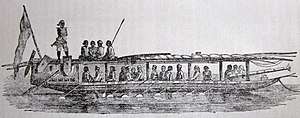Kakap (boat)
.jpg)
Kakap (also known as salisipan) is a canoe-shaped boat which sometimes have outriggers. Kakap is often used by the Iranun and Banguingui people of the Philippines for piracy and for raids on coastal areas. They are usually part of fleets with larger motherships like pangajava, garay, or lanong warships. Among Malays, this type of boat is used as a boat of war or passenger boat.[1]
Description
Kakap resemble pangajava but are smaller and lighter. It also uses a mast and rectangular tanja sail. The boards and planks on the hull are not nailed, but are attached using a wooden peg technique and reinforced with rattan bonds. Larger kakap is able to reach eight meters in length and able to carry 10 crews. Usually the crews are crew members of pangajava.
Role
Kakap does not travel alone and often accompany larger motherships like pangajava, garay, and lanong. It is used as a scout for piracy. If merchant ships came across this type of boat, there would have been pangajava or lanong hiding around the waters. Kakap is also suitable for cruising the beach and sailing to rivers. If attacked, kakap can easily land on the beach or riverside so the crew would flee to the mangroves or palm areas while carrying the boat with them. Orang laut use kakap that can accommodate 20 people for piracy and raids.[2]
